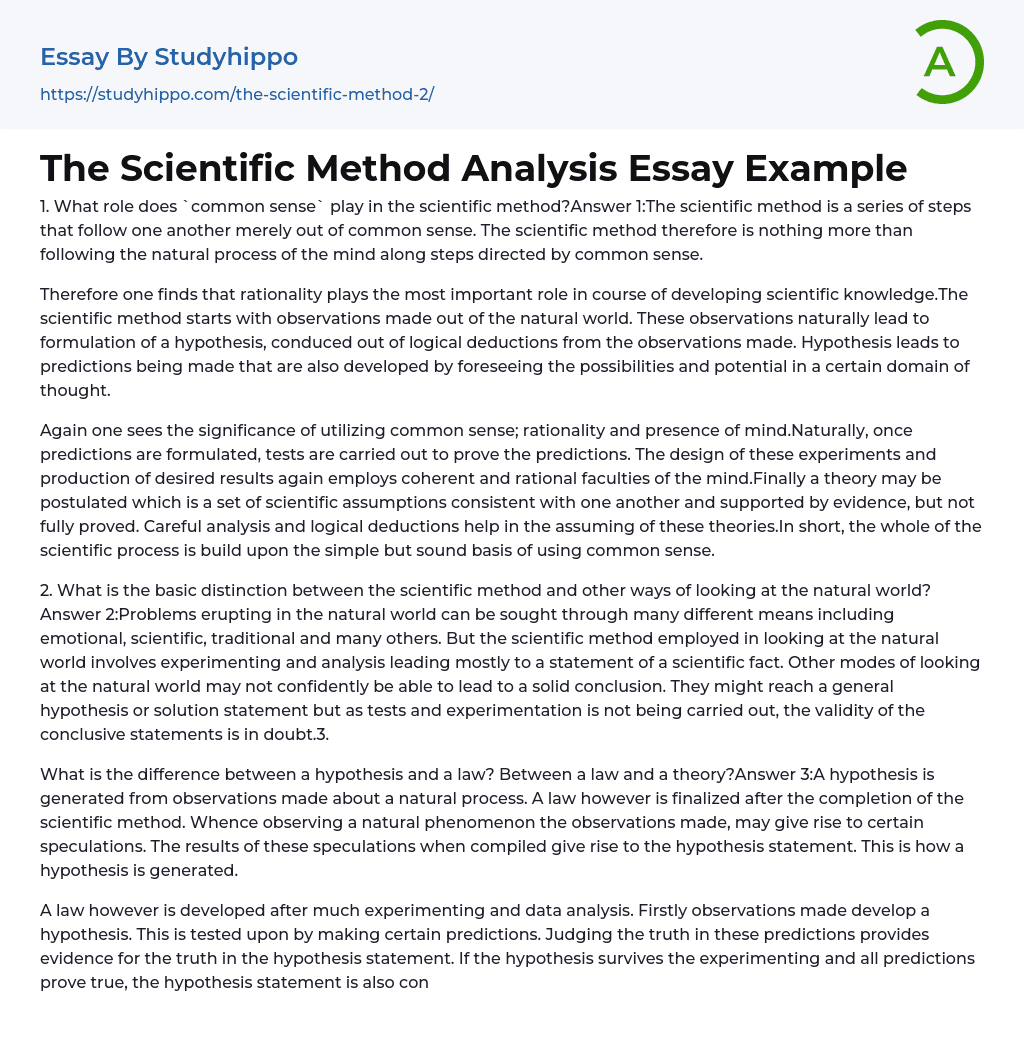1. What role does `common sense` play in the scientific method?Answer 1:The scientific method is a series of steps that follow one another merely out of common sense. The scientific method therefore is nothing more than following the natural process of the mind along steps directed by common sense.
Therefore one finds that rationality plays the most important role in course of developing scientific knowledge.The scientific method starts with observations made out of the natural world. These observations naturally lead to formulation of a hypothesis, conduced out of logical deductions from the observations made. Hypothesis leads to predictions being made that are also developed by foreseeing the possibilities and potential in a certain domain of thought.
Again one sees the significance of utilizing common sense; rationality and presence of mind.Naturally, once predictions are formulated,
...tests are carried out to prove the predictions. The design of these experiments and production of desired results again employs coherent and rational faculties of the mind.Finally a theory may be postulated which is a set of scientific assumptions consistent with one another and supported by evidence, but not fully proved. Careful analysis and logical deductions help in the assuming of these theories.In short, the whole of the scientific process is build upon the simple but sound basis of using common sense.
2. What is the basic distinction between the scientific method and other ways of looking at the natural world?Answer 2:Problems erupting in the natural world can be sought through many different means including emotional, scientific, traditional and many others. But the scientific method employed in looking at the natural world involves experimenting and analysis leading mostly to a statement o
a scientific fact. Other modes of looking at the natural world may not confidently be able to lead to a solid conclusion. They might reach a general hypothesis or solution statement but as tests and experimentation is not being carried out, the validity of the conclusive statements is in doubt.3.
What is the difference between a hypothesis and a law? Between a law and a theory?Answer 3:A hypothesis is generated from observations made about a natural process. A law however is finalized after the completion of the scientific method. Whence observing a natural phenomenon the observations made, may give rise to certain speculations. The results of these speculations when compiled give rise to the hypothesis statement. This is how a hypothesis is generated.
A law however is developed after much experimenting and data analysis. Firstly observations made develop a hypothesis. This is tested upon by making certain predictions. Judging the truth in these predictions provides evidence for the truth in the hypothesis statement. If the hypothesis survives the experimenting and all predictions prove true, the hypothesis statement is also considered true and is promoted to the level of a theory. A theory is supported by a lot of experimental data.
But all is not sufficient to erase all factors of doubt in it completely.When all factors of doubt are erased and the theoretical statement is found to be in accordance with all the existing scientific laws and knowledge, being critically judged by the scientific community, the validity of the theory is asserted and the theory is updated as LAW, acceptable as it is then to the whole scientific community.4. Scientific models do not correspond exactly to
reality. Why are they nevertheless so useful?Answer 4.
Scientific models are a close approximation to their existing counterpart situations in the real world. They are models that correspond to and exemplify practical situations yet are far from being exactly similar to the real world example. This is mainly due to the innumerous complications involved while dealing with the real world. Most real life situations are so interlinked with other situations that they are extremely difficult to isolate and disengage from the rest of the less significant environment. Therefore a close approximation is generated in which the actual system under consideration is made prominent against the less significant surrounding.
Scientific models however although do not exactly correspond to ht e real life situation but are highly useful in carrying out scientific analysis(The National Academies Press ,n.d.).The reason for this is that not only scientific models are the closest possible approximation to the natural phenomenon but they also provide a more simplified version of the actual problem cutting down less essential en highly complex details.
This highlights the genuine problem and increases chances of getting nearer to a possible solution.The model also provides the basic data base to work upon in solving the situation. Finally it is the closest possible one can get to reality without blowing the problem solving out of proportions. There fore it is significant to create a model and it is definitely highly useful.




